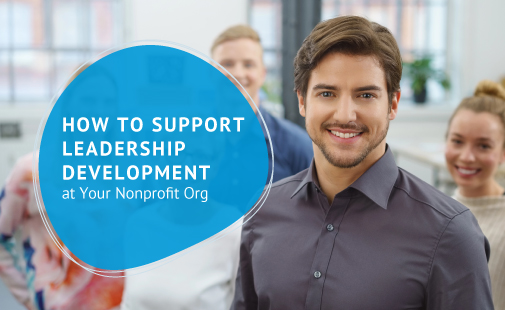Your nonprofit is a ship, constantly charting a path forward through changing waters. Nonprofits with a reliable captain steering that ship are better equipped to tackle obstacles, act on opportunities, create and execute future plans, and cultivate a positive, productive work environment.
Of course, to maintain strong leaders long term, your nonprofit needs to support leadership development. By investing in your workforce, you can not only build a more resilient team but also improve operations across the board.
In this guide, we’ll explore strategies for developing leaders at your organization. But first, let’s examine why leadership development programs matter.
Importance of Leadership Development
As many organizations struggle to find valuable employees in their local communities, training and promoting from within becomes increasingly important. Investing in these employees’ skills—both for leadership development and general advancement—allows you to cultivate a more reliable, knowledgeable team.
Plus, providing employees with clear growth pathways can lead to higher retention rates. Astron Solutions’ employee recruitment and retention report indicates that 93% of employees stay with their employers longer if they invest in their professional development.
In general, nonprofits that empower employees to be leaders yield more skilled workforces and greater employee loyalty. Implementing effective leadership development strategies can make the difference between realizing these benefits and struggling to fill leadership roles.
3 Leadership Development Strategies
1. Discuss advancement opportunities with employees.
Not every employee is interested in a leadership position. Some may have plans to move on from your organization, whereas others may wish to advance their careers by taking on more advanced projects but not necessarily managerial responsibilities.
To invest in employees who are passionate about leading your nonprofit, you first need to identify them. This means having open, transparent conversations about advancement with your team. A few opportunities to do this include the following:
- Performance reviews. Performance reviews are an opportunity to sit down with employees and discuss how they have contributed to your nonprofit over the past year, quarter, or other time period, based on your review calendar. These conversations should also have space for discussing employees’ futures at your nonprofit. Ask employees directly about their growth goals to find those who are both interested and ready for leadership positions.
- New positions open. When you know a leadership position is about to open, you should have a plan for how to fill it. If you’re interested in promoting internally, use this as an opportunity to gauge interest among employees. For example, you might need an additional supervisor after growing your fundraising team rapidly. In this case, you could reach out to the senior members of the team to identify prospective candidates.
- Employees express an interest. If an employee expresses a desire for growth opportunities to a manager, take their interest seriously. While you may not always have open leadership positions, helping employees improve their skills will set you up for success when roles become available.
When it comes to promoting leadership opportunities, be aware that you’ll likely often have more candidates than open positions. Strive to help employees feel they are advancing their careers, whether through promotion into a leadership role or another form of professional growth.
2. Create structured growth pathways.
Moving up through the ranks of your nonprofit should be a straightforward, organized process. The exact pathways will vary depending on your organization and employees’ specific positions. However, in general, this process should involve helping employees learn more about your organization and test their leadership skills before officially accepting a senior position.
A few possible growth pathways you might offer include
- Providing shadowing opportunities. Allow employees to shadow individuals whose positions they’ll take on. This lets employees know what will be expected of them and even get hands-on experience prior to moving into their role.
- Offering new projects. Give employees the opportunity to undertake projects outside of their normal duties that allow them to put new skills into practice and challenge themselves. Of course, if employees accept new responsibilities, be sure to update their job descriptions to reflect their new role.
- Considering implementing a job rotation system. Job rotation systems involve employees moving through several positions at your organization. This might mean shifting between various departments to learn how other parts of your nonprofit work or, commonly as part of succession planning, briefly stepping into a more senior position.
When employees see clear ways to advance, they’ll feel more engaged and motivated, knowing they have a future at your nonprofit. If employees express interest in growing their role at your nonprofit, point them toward the pathway that fits their needs and your nonprofit’s current priorities.
3. Provide upskilling resources.
According to eCardWidget’s guide to remote employee recognition, 59% of employees seek out and pay for their own upskilling and development training. This finding shows that many employees are eager to develop their careers but need the right resources to do so.
You can help your team by providing advancement resources through your nonprofit. For example, you might offer one or more of the following options:
- Online courses. Virtual offerings are often the most accessible, especially if you have remote employees. This option provides flexibility, allowing employees to complete them at their own pace, no matter where they’re located.
- Conferences. Send team members to conferences for nonprofit professionals. Here, they can connect with others in their field, attend lectures, and get up to speed on the latest best practices. To make the most of conferences, you might even have conference attendees give presentations for your team when they get back, so your entire staff can benefit.
- Whole-team workshops. Host training sessions that help all team members discover ways to develop their skills. While some employees will be more ready for leadership roles than others, workshops can serve as both training and team-building opportunities.
If you plan to offer upskilling resources, consider how you can incentivize employees to take advantage of them. While some will do so voluntarily to achieve their own advancement goals, others may need to be reminded that these offerings exist.
The best way to attract and retain valuable talent is to show that your nonprofit is ready to invest in them. Establishing leadership development pathways lets employees envision a future at your nonprofit and take active steps to achieve it.
Consider the leadership roles your employees may step into one day, and how you can best prepare them for these positions. Speak with your team to learn their career goals, and create a plan that helps them complete the steps needed to achieve those goals.
About the Author:
Jennifer C. Loftus, MBA, SPHR, PHRca, GPHR, SHRM-SCP, CCP, CBP, GRP
Jennifer C. Loftus is a Founding Partner of and National Director for Astron Solutions, a compensation consulting firm. Jennifer has 23 years of experience garnered at organizations including the Hay Group, Parsons Brinckerhoff, Eagle Electric Manufacturing Company, and Harcourt General.
Jennifer has held volunteer leadership roles with SHRM, New York City SHRM, and WorldatWork. She serves as a subject matter expert to the SHRM Learning System and as a SHRM instructor. Jennifer is a sought-after speaker for local & national conferences and media outlets.
Jennifer has an MBA in Human Resource Management with highest honors from Pace University and a BS in Accounting summa cum laude from Rutgers University.
Jennifer holds Adjunct Professor roles with Pace University, Long Island University, and LIM College.
Jennifer received the 2014 Gotham Comedy Foundation’s Lifetime Ambassador of Laughter Award.







